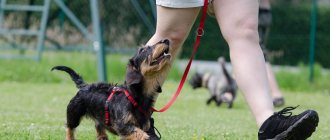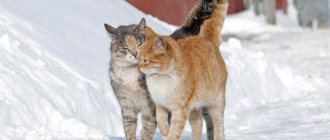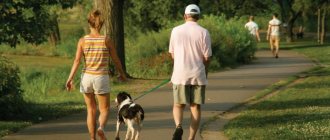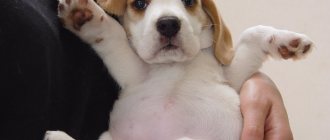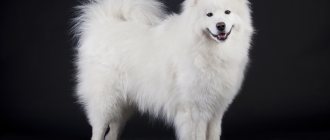Why do you need to walk your puppy outdoors?
For full development, it is important to provide a healthy dog with active movement, and the street is perfect for this. In addition, during a walk, new smells and sounds are learned, which is also an important part of development. On the street, the puppy gets to know other animals, looks attentively, remembers their habits and learns to interact with them.
Dogs need walks in the fresh air
Being in the fresh air, the dog learns the rules of behavior. In this case, all responsibility lies with the owner, because the training of commands and the future behavior of the baby depend on him.
For pets, except decorative breeds, the street is a place where they can relieve their natural needs. To this end, the owner must teach the puppy to go to the toilet outside. If this is not done, then permanent puddles at home are guaranteed.
Having found out how many months you can walk with a puppy, you need to gradually begin to accustom your pet to going outside the apartment.
Important! Frequent walks with puppies and adult dogs are a must. Huskies, terriers, spaniels, jacks, corgis and labradors especially enjoy long walks. These breeds need space, so it is better to choose parks and forests for walking.
How long should you walk your puppy after the first walk?
After the first walk, gradually increase the walking time, based on the baby’s sensations. But there are unspoken rules that cannot be broken, regardless of the mood of your pet and its breed:
- Don't give your puppy too much exercise. Since the baby is still growing, you should not overload his muscles and joints. Excessive physical activity has a particularly bad effect on dogs of breeds prone to joint dysplasia.
- Don't walk your pet for too long. For a puppy from 3 to 6-7 months, 2-3 walks a day lasting 1-1.5 hours will be enough. Of course, do not forget to rely on the characteristics of your baby’s breed. For puppies of breeds such as Labrador, Border Collie or Siberian Husky, walks can last up to 2 hours, twice a day. While, for example, large and heavy Molossians will need 1-1.5 hours a day with the same frequency. However, remember that even dogs of decorative breeds also need exercise. A puppy needs activity, mental and physical exercise, play and fresh air, regardless of its breed. Whether it's a baby Chihuahua or a tiny Yorkie, these are dogs, not cats. There is no way to keep them in an apartment forever.
- Train your puppy. To ensure that walks with your beloved pet are not a burden, but bring joy and pleasure, teach your baby. Before the first walk, let the commands be “come to me” and “no”. They will help you control your puppy on the street and concentrate his attention on you, even in conditions that are still unusual for a pet. After several walks, learn the command “nearby”, gradually adding and practicing the commands “sit”, “lie down”, “wait” and others on the street. This way you will teach your little kitten to work not only in the apartment, but also in the fresh air and among city streets.
READ Alabai puppies: main rules for choosing care and education
Everything you just read is the main points that you should know about the duration and content of walks with a four-legged baby. Maybe you have something to ask or add? Write your thoughts in the comments, it’s interesting to read about how you walk with your pets!
How long to wait before your first walk
When can you walk your puppy after the second vaccination?
Of course, any owner who is concerned about the health of their pet is interested in the question of when can they walk their puppy. The first walks should start smoothly. It is important that the dog can get used to the street and not be afraid of the surrounding vegetation and other pets.
The first walk with the puppy should be in warm weather
You also need to know at what age the puppy can be taken for its first walk. So, with strong and healthy pets, you can go for a walk at the age of one and a half months. There are two conditions for such a walk:
- the weather should be warm outside, that is, at least 10 degrees;
- The pet must be held in your arms.
In all other cases, the optimal age is 3 months, when the dog has already received a course of vaccinations. Already at this age, the puppy can walk on its own, and not in the arms of the owner.
The age at which you can walk your puppy also depends on the breed. For example, large guard breeds need to be accustomed to the street from childhood, unlike short-haired representatives. Therefore, it is necessary to organize walks at the age of one month. Decorative breeds do not tolerate bad weather, so the best solution would be to wait until they get stronger and are vaccinated.
Important! The puppy should be taken for a walk in your arms, since its bones are still weak, and it is forbidden for it to move on stairs. This is especially true for the French bulldog breed, which is vulnerable to various types of severity.
Pet owners should find out if their pet's mother is vaccinated. If she has had all her vaccinations, then by the time she gives birth she has strong immunity, which means that the puppy is protected from infection for up to 3 months. In this case, you don’t have to hold him in your arms while walking.
Decorative breeds, Yorkshire terrier, chihuahua, pug, spitz do not need constant walking. Yorkies and other decorative breeds are considered pocket dogs for this reason.
Proper walking based on your pet's breed
Next, we will look at the most popular breeds of domestic dogs today and how to walk them correctly, based on the specific nature of the dog in relation to its breed:
- Husky. This breed is very susceptible to diseases of city pets, because its nature was formed and intended for completely different living conditions. Because of their “cleanliness,” huskies are a kind of tasty bait for various parasites - fleas, lice eaters, ticks, etc. Therefore, the owner needs to thoroughly prepare the little pet for the first walk, especially in the city. This breed is more resistant to viral and infectious diseases.
- Chihuahua. The first walk with a puppy of this breed should take place no earlier than the pet is 5-6 months old. Despite their apparent fragility, Chihuahuas have strong immunity and are immune to illness, adapting to any climate. Do not be mistaken when considering a walk with this miniature pet, carrying it in your arms or, especially, in a bag. This is a living and very mobile creature that also needs to warm up. Naturally, it is better for your pet to take its first steps in the fresh air away from roads and strangers, especially dogs. A clearing in a park with short grass is best.
- Dachshunds. They begin to walk pets of this breed only after a full range of necessary vaccinations. In terms of age, this is approximately 3 months. During the first walk, the dachshund will be a little stressed due to fear of the unknown, so it is better to carry out this event without letting him out of your hands for a long time. If the puppy is very active, you can let him out to run, but with a minimum number of strangers. If the dog is frightened of something, do not try to immediately grab it in your arms - pet it, calm it down in an even tone of voice, call it by name. You quickly get used to everything good - and dogs are no exception. If you carry your pet in your arms all the time, he will refuse to run on his own. Under no circumstances should you use the now popular roulette leash when walking your dachshund. Due to the physiology of this breed, this will cause some physical pathologies in the animal.
- Yorkshire Terrier. Many people choose small dogs for themselves, hoping that they don’t necessarily need to be taken out into the fresh air for a walk, and that they can crap at home, once they are trained to use a litter box. But this is absolutely false. The Yorkshire Terrier needs to be walked in the same way as other dogs. Imagine for a second that you are locked in an apartment and are not allowed out. Reclusion will be reflected in depression in the animal; it will simply “fade away”, despite the best conditions and nutrition. Not everyone knows that by its nature this breed is a hunting breed, which was specially bred in old England to catch rodents. Therefore, after the standard first vaccinations, you can safely take your pet out for a walk.
Jack Russell Terrier. The duration and number of walks with the puppy depend entirely on its age. After quarantine, it is better to take the dog outside for short visits. In wet weather, it is better to reduce the duration of walking as much as possible, since this breed is very susceptible to respiratory diseases. It will not be superfluous to insulate your pet with a blanket. You should not completely cancel walks, this will have a bad effect on your dog’s mood.- French Bulldog. Quarantine after the first mandatory vaccinations for a French bulldog lasts about a week. Walking is preferable after each meal in order to develop the necessary reflex and routine. Such walks should not be long, but rather become a kind of “potty” trip. It is worth understanding that during the first walks you will have to carry your pet a lot in your arms, since puppies of this breed are contraindicated from walking on steps. If the owner does not know this, over time his dog’s spine will become deformed, the size of its paws will change, and a hernia may appear.
When and how long can you walk with your newborn in winter?
Usually it is winter that raises the most questions for young mothers. Namely, they worry that the cold is dangerous for the newborn, and that the baby may catch a cold and get sick. How can we be here? Should I wait a couple of months or go out for a breath immediately after returning from the hospital?
Let's just say that all fears are in vain if the child is dressed correctly and warmly. Moreover, in winter it is much more convenient and easier to walk with a baby, because dressing warmly is the only problem and task of parents, which, as a rule, is not difficult to solve.
Advantages of walking in winter for a newborn:
- You can go outside at any time of the day (there is no heat and stuffiness like in summer);
- It is almost impossible to overheat a child, because he can lose all excess heat through breathing (inhales cold air, exhales warm air).
- There are no insects from which the baby needs to be saved.
You may ask, at what temperature can you walk with a newborn? On the Internet you can find a huge number of options for answering this question. Everyone fantasizes as much as they like, to the extent of their thermophilic nature. They even go so far as to answer the question of when you can start walking with a newborn in the winter, but they do not recommend doing this if the thermometer shows below zero degrees and the child is under 2 months old. Naturally, this is complete absurdity.
Fresh air is important for children of any age, and especially for newborns! And no amount of ventilation can replace a full stay on the street or balcony. Western doctors have long been convinced that a child is comfortable outside in winter, even at fairly low temperatures, provided that he is warmly dressed.
To answer the question of how long you can walk with a newborn in winter, let’s turn to the official document - SanPin for preschool institutions dated May 15, 2013. According to this document, daily walks lasting 3-4 hours are recommended for children. If the air temperature is below minus 15 degrees, and the wind speed is stronger than 7 m per second, it is recommended to reduce walks (but not cancel them completely).
As a rule, for children under 4 years of age, walks are canceled if the air temperature is below minus 15 degrees, and at the same time the wind speed is stronger than 15 meters per second. And this happens very rarely.
So how long can you walk with a newborn in winter at different temperatures? Let’s collect all the information received in a table for clarity.
| Temperature and wind | Walk duration |
| Above minus 15 degrees, wind speed less than 7 m/s | 3-4 hours a day |
| Below minus 15 degrees, wind speed more than 7 m/s | 2 hours a day |
| Below minus 15 degrees, wind speed more than 15 m/s | Not carried out |
When answering the question whether it is possible to walk with a newborn in severe frost, it is worth first understanding whether this temperature for your area is truly anomalous (for example, minus 30 degrees in central Russia or the Urals), or standard, at which you will spend the next few days. 4-5 winter months (Siberia, Northern regions).
If the first option, then it is wiser not to be a hero and wait out the frost at home, ensuring comfortable conditions in the room where the child is, and regularly ventilating it.
And if you have to live at such temperatures, and they are not something out of the ordinary for you, then it is wiser to walk, at least a little and dress very warmly.
In addition, purchase in advance a special baby cream to protect your cheeks and nose from frost - it will protect delicate skin from chapping and frostbite.
Why do puppies need quarantine for the first 2 weeks after vaccination at 3 months?
Walking dogs: how many times a day should you walk by time?
To protect the life of your pet, after a course of vaccinations, you must comply with quarantine. Animal immunity develops faster against a number of diseases, but protection against leptospirosis and rabies appears only 2 weeks after the course has been completed.
After vaccination, the dog's activity decreases for several days
After vaccination, the dog's behavior must be closely monitored. In the first three days, the dog is characterized by a decrease in activity. Babies may whine in fear. Side effects are also noted:
- refusal to eat;
- itching;
- lethargy;
- intestinal disorders;
- increase in temperature.
A veterinarian's consultation is required if your dog behaves in the following ways:
- The dog itches, chokes, the mucous membrane turns blue. All these are symptoms of anaphylactic shock.
- The temperature reaches 39 degrees, accompanied by weakness, cramps, vomiting and frustration.
Is quarantine mandatory?
Although it seems that vaccination is a fairly simple procedure, after it the dog’s body becomes weakened. During this period, your pet can contract a number of diseases that can be fatal. This is why quarantine is not only possible, but required.
In this case, it means complete isolation from society. If for an adult dog such restriction from the outside world is not necessary, then for a puppy it is vital.
Rules of conduct for 2 weeks after administration of the vaccine:
- Limit the puppy's interaction with other animals.
- Limit contact with objects that may contain viruses (outdoor shoes, etc.).
- Give up the idea of walking your pet.
- Avoid water procedures.
- Do not introduce changes to your usual diet.
- Reduce physical activity.
Important! During immunization, it is worth asking your veterinarian when the puppy can be taken outside. He will be able to determine the time period if the owner is afraid to make a decision himself, and will tell him when walking will be allowed.
Brief instructions for raising a toy terrier puppy
Place for a puppy. It is necessary to prepare a place for the puppy (preferably a cat house), put in it a bedding in the form of a mattress with a replaceable pillowcase. The place should not be located on the aisle or near a radiator. The puppy should have toys (rubber), do not let him play with shoes or clothes. Fresh water (not milk) should be available in an accessible place.Feeding. From 1 to 2 months - 4 times a day, from 2-6 months - 3 times a day, after 6 months - 2 times. Don't overfeed your puppy! Do not suddenly change your feeding diet! To prevent intestinal disorders, the medicine cabinet should contain bifitrilak and lignin.
Products for feeding. Cottage cheese, kefir (milk can weaken), boiled egg (yolk only), no more than once a week. Meat - beef, both raw and boiled, chicken (boiled only), pork is not allowed in any form. Fish - boiled sea fish of low-fat varieties, cleaned of bones. Porridge - any: milk or cooked in meat broth. Vegetables - zucchini, carrots, cabbage, greens, fruits; bread croutons. You should not give your puppy peas or legumes; spicy, salty, smoked foods. You can feed with ready-made food (water must be present). When feeding with ready-made dry food, no additional feeding is needed. When feeding cereals, it is necessary to give mineral and vitamin supplements, strictly observing the dosage.
Games. You definitely need to play with the puppy. During the game, from 1 month onwards, teach simple commands, accustom them to nicknames, “place”, “fu” (meaning “spit out what you put in your mouth”). A toy terrier puppy should not be stroked on the head, pulled anything out of its mouth, or allowed to go down stairs (up to 4 months).
Care. It is necessary to trim the claws once every 1.5-2 months; clean your ears with a cotton swab soaked in hydrogen peroxide or special lotions. When changing teeth, you need to take care of your teeth. Often, primary canines have to be removed at a veterinary clinic. During the period of changing teeth, you should let the puppy chew on a raw beef bone (a large one so that the puppy cannot chew it).
Vaccination. At the age of 2-2.5 months, a toy terrier puppy can be given the NOBIVAK vaccine - 2 times with an interval of 21 days, 10-14 days after the second vaccination you can go for a walk. After vaccination, the puppy cannot be bathed for 14 days. After changing teeth (at 6.5 - 7 months), another NOBIVAK vaccination is necessary, and after 21 days - a rabies vaccination. Then after this, vaccinations are done once a year throughout life.
Protection from parasites. 10 days before vaccination, the puppy should be given an anthelmintic (for example, drontal, kanikvantel or another). Dosage and recommendations must be strictly followed. For prevention, the dog is wormed 4 times a year, or once every three months. During the period from April to October, it is necessary to protect the dog from fleas and ticks (drops, sprays).
Bathing. It is not advisable to bathe a puppy under 6 months with shampoo and soap. After a walk, you can wash your paws with warm water and wipe dry. It is necessary to protect the puppy from drafts.
Attention! A fall from a height is very dangerous for a puppy: a blow to the head when falling from 1.5 meters can result in a concussion and even death. Therefore, when you take the puppy in your arms, hold it tightly; when you try to break free, grab it by the neck like a goose - this grip is the most reliable. Don't leave your puppy alone on the couch until he can jump on it himself. When moving around the house, sitting in a chair or on a sofa, be careful not to step on or sit on the puppy.
Toilet. Train your puppy to go to the toilet using a tray or newspaper. All this will require care, time and patience from you, but in return you will receive a long (up to 15-20 years) pleasant communication with a very small, but such a great friend - your toy terrier.
Walks. You need to start walking your puppy 10-14 days after the second vaccination, not earlier. There is no need to take the puppy outside until this time, even in your arms, because... there is a possibility of contracting an infection that is carried through the air. However, after quarantine (vaccination), try to walk your dogs as much as possible. As much as time allows.
Make sure that before going outside, your puppy knows and follows the “Handles!” command well. There is no need to walk your puppy on a leash. The absence of a leash forces the dog to constantly keep you in sight and run after your legs without lagging behind even a step. If he is on a leash, he begins to believe that HE is the one walking you, but without a leash he loses self-confidence. Although there are exceptions to the rules. Especially in males.
If you're walking without a leash, it's a good idea to hang a bell on your dog's collar. This way you can always hear where your dog is running and whether he is lagging behind. Of course, the dog must also know the leash. This will come in handy when going out into the city, where there are crowds of people and the possibility of getting lost; it will make it easier to accustom the dog to the ring.
In autumn, spring and winter you can wear overalls on your toy. Clothes are especially needed in winter, in cold weather. This will significantly lengthen your walking time. For winter, you need to sew boots with a small padding padding on the sole because... In the snow, it’s his paws that get cold first.
If the puppy is active, and there is little time to walk or it is too cold (below -10), you can practice 7-10 minute swimming in the bathtub twice a week. After swimming, be sure to dry the puppy with a towel and dry the coat with a hairdryer.
Rules for walking after vaccination
German Shepherd: caring for a puppy and an adult dog
The first walk with the puppy on the street should leave him with vivid impressions, because it is important that the pet is not afraid to be outside the apartment. For a successful walk, you need to choose the right place. When going out 2 weeks after the vaccine is administered, you should organize a walk in your arms. You cannot let the puppy down to the ground.
A number of rules must also be followed:
- The day should be sunny and calm.
- You should choose a quiet place where there is no waste or other animals.
- The withdrawal time should be no more than 20 minutes.
Before going outside, you need to make sure your pet is feeling well. He should not have lethargy, drowsiness or fever.
Walk in your own area
If the owner has his own plot, fenced from prying eyes, then it will be an ideal option for organizing a walk. The Beagle dog breed will especially like this alternative.
Since puppies are quite curious, before going for a walk you should remove from the area all objects that they can eat. The same should be done with potentially dangerous items. Attention must be paid to the strength of the fence, because while on the site, the baby may want to frolic behind the fence.
Walking outside
Since the street is a public place, a number of rules must be followed:
- Put a collar and leash on the puppy.
- If the weather is cool, then wear warm overalls.
- Watch carefully so that the baby does not pick up any objects from the ground.
Active dogs need to be closely monitored when walking.
What should I dress my child in?
The principle of selecting clothing is based on its suitability to weather conditions. If it’s hot outside, the baby can be dressed in a bodysuit (or blouse). Very young children are usually covered with a light diaper. Accordingly, cooler weather requires that the baby wear rompers, additional blouses, a suit and a hat. More convenient are modern overalls, which replace several things at once and are convenient for quickly dressing a child. Overalls can be winter, demi-season and very light (made of thin knitwear, so-called slip overalls).
Winter overalls in combination with a sleepsuit or blouse and rompers are used at air temperatures below +5°C.
Some mothers prefer to use envelopes for walking with their children in the first weeks of life. Envelopes also come in different varieties - from a lightweight version (for example, made from fleece fabric) to a rather warm, fur one.
How to properly walk a puppy without vaccinations
Not all pet owners have had their pet vaccinated. Of course, you can walk an unvaccinated puppy, but you must carefully monitor its behavior on the street and subsequently upon arriving home.
Owners also need to know when they can start walking their puppy outside without vaccination and how to do it correctly. So, you can take him outside for no more than 1 hour. If he feels uncomfortable, then you need to return home as soon as he relieves himself.
Important! In order for the pet to develop correctly, it must be allowed to walk with other dogs.
If you limit your dog's communication, in the future he may display unreasonable aggression towards his own kind or cowardice. The social circle for a puppy without vaccinations should be chosen personally. It is best to let him walk with domestic dogs that are vaccinated. If he is not vaccinated, you can vaccinate yourself with Nobivak.
How to walk a puppy for the first time?
Note. Approaches that apply to puppies during the socialization period or later are described here. For raising puppies older than 5 months. These tips may not work.
Usually puppies at the age of 2.5 months go outside relatively calmly. At 3 months The “age of fear” begins and the puppy begins to be afraid. He will also be afraid if he is outside for the first time at this age. At 4 months the puppy has already missed most of the socialization period in which he would have mastered the language of his species well. A puppy who first finds himself on the street in the city at the age of over 4 months, with rare exceptions, will be afraid and this fear can lead to very serious problems. Therefore, the main rule for all dog owners in connection with walks is:
Start walking as early as possible and continue walking - every day and at least 3 hours a day! Bad weather, poor health, fear of the dog being outside - these are not excuses for reducing the number and duration of walks with the dog!
Entrance
For the first few days, it is advisable to carry the puppy in your arms. For the first time, bring the puppy into the house in your arms. Starting from the second day, carry it out of the house in your arms, and let the dog return with its paws. Take your time - let her explore the entrance, sniff the corners, stand in the doorway, walk up the stairs. At the same time, don't let your dog shy away, run away from you, or refuse to go. If this happens, hold the leash or gently pull her along with you. If the puppy is wearing a harness, pulling him will not be difficult. It is harmful to drag a puppy by the collar, so you can make an improvised harness - insert a leash under the puppy’s belly and pull it by the collar and the loop that supports the puppy under the belly.
On the street
1) never pet or calm the puppy while he is afraid, tucks his tail, ears, etc. Only if the puppy is trembling can you pick him up and carry him away. As long as it doesn't shake, just wait. As soon as he showed courage, went to sniff something or became interested in another dog, then praise and pet him. This will tell the puppy: well done, now you are doing the right thing. 2) try not to let the puppy crawl into your legs. As soon as he tries to do this, take a step or two in place or to the side. The puppy can walk under your feet - this is normal, but he should not press his back into them as if in a corner. 3) with such a puppy the principle works: “one step forward, one step back.” Relax, straighten up, show the dog that you are not afraid of anything, which means there is nothing to be afraid of. Drag the puppy in the harness by the leash just one step forward to what he is afraid of (a car, a dog, a stranger, etc.) and wait. As soon as he stops trying to get back and pull on the leash, take a step (just one) back (to where the dog is trying to go). Praise. Wait. Step forward again. Wait. Relaxed - step back. After several repetitions, the puppy will take a step forward calmly. Give good praise. Step back. And then take 2 steps forward. You will have to spend two hours on such a walk. The next day, within an hour, you will need to act on the same principle. Usually, after this, the puppies begin to walk confidently and get to know dogs more easily. 4) now that the puppy has begun to walk normally on the street, urgently introduce him to everyone who will not eat your puppy - dogs, children, old ladies
